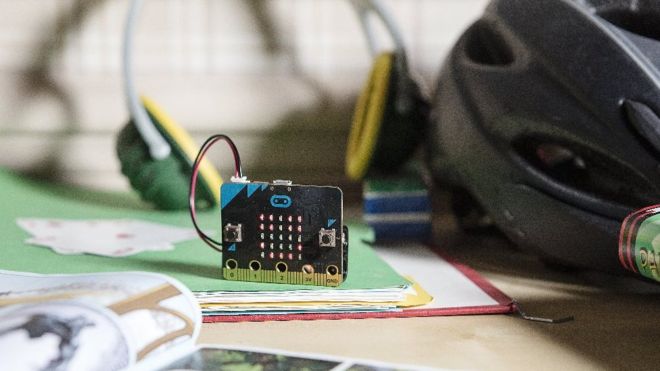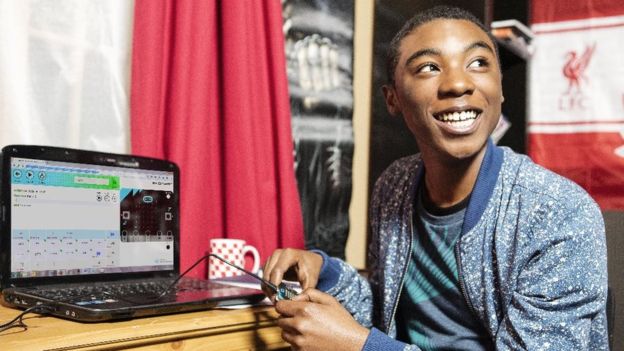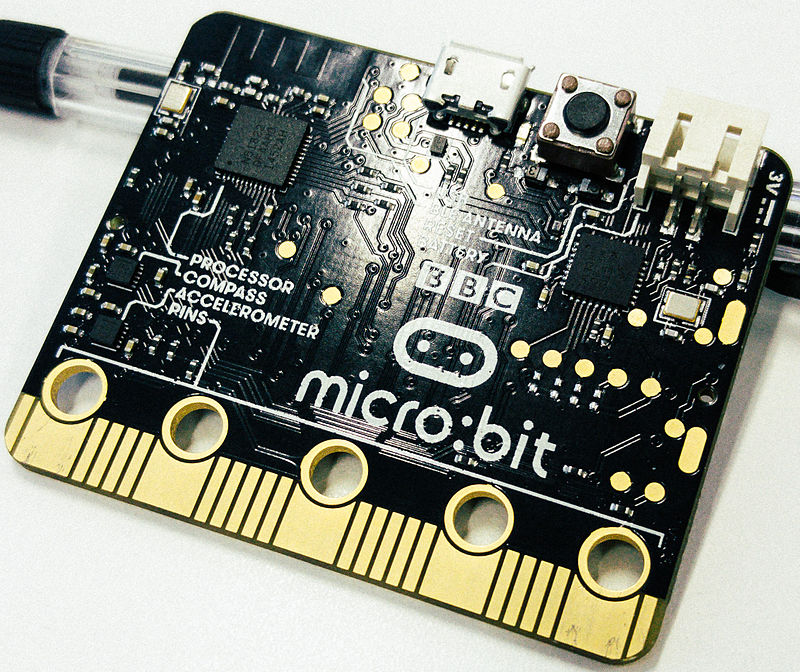Microcomputer micro: bit from the BBC is already available
micro: bit can be interesting for both children and adults

Photo: BBC
About a year ago, the BBC company announced its intention to distribute a million miniature PCs to schoolchildren in the UK. Clearly, not for entertainment, but for study (developed by Touch Develop, Python, and C ++). The target audience of the project were schoolchildren aged 11-12 years. It was also promised to make this mini PC compatible with Raspberry Pi, Arduino, Galileo and other mini PCs.
')
This year, the promise was realized, and on March 22, the company began sending devices to all schools that subscribed to the micro: bit program. The authors of the project believe that this kind of electronic device will help develop in the younger generation an interest in the study of modern technologies. Interestingly, this is the second such project from the Air Force, the first was implemented in the 1980s, it was called BBC Micro .
When microcomputers began to be distributed, the company announced that after some time the system could be purchased (it was suggested that the initial price was 4-5 pounds sterling). The development itself was attended by partners, including Microsoft, which provided the project with its own development environment, the Touch Develop platform. The South Korean corporation Samsung also helped by developing an application on Android. NXP has provided a USB controller, accelerometer and magnetometer to the project. In general, the number of project partners has increased over time to 20.

Students received not just a fee, but a whole package, with the module itself, a USB cable and a power supply from batteries. Plus, it was supplied with this package and instructions on as many as 32 pages. For optimal work with the chip, registration is supposed to be on the micro: bit project site, where there is everything necessary for development. The site was developed by Microsoft.

The microcomputer specifications are as follows:
Now it became known that this mini-PC has already gone on sale. True, its price is twice as high as the cost of the same “raspberry”, Raspberry Pi. You can buy your micro: bit for £ 12.99. This is the cost of one module. A kit with USB and several introductory classes will cost the buyer already £ 15. 10 of these kits sell for £ 10 and can be purchased for £ 140. The company provides various kits for retailers and their partners. They can also be bought, or it will be possible after some time.
The board has several programmable buttons, a number of sensors and LEDs. Supports wireless data transmission via Bluetooth. There are also own applications for iOS and Android platforms .

Third-party manufacturers produce for the project accessories and add-ons. For example, the resource MyMiniFactory provides ready-made models of enclosures and other parts for the board, which can be printed on a 3D printer.

As you can see, you can make a lot of things out of the board, there would be a desire and time. This board is also interesting for adults, and for children - features, because on the basis of micro: bit, you can create a robot, a clock, and a module for a smart home security system.

Photo: BBC
About a year ago, the BBC company announced its intention to distribute a million miniature PCs to schoolchildren in the UK. Clearly, not for entertainment, but for study (developed by Touch Develop, Python, and C ++). The target audience of the project were schoolchildren aged 11-12 years. It was also promised to make this mini PC compatible with Raspberry Pi, Arduino, Galileo and other mini PCs.
')
This year, the promise was realized, and on March 22, the company began sending devices to all schools that subscribed to the micro: bit program. The authors of the project believe that this kind of electronic device will help develop in the younger generation an interest in the study of modern technologies. Interestingly, this is the second such project from the Air Force, the first was implemented in the 1980s, it was called BBC Micro .
When microcomputers began to be distributed, the company announced that after some time the system could be purchased (it was suggested that the initial price was 4-5 pounds sterling). The development itself was attended by partners, including Microsoft, which provided the project with its own development environment, the Touch Develop platform. The South Korean corporation Samsung also helped by developing an application on Android. NXP has provided a USB controller, accelerometer and magnetometer to the project. In general, the number of project partners has increased over time to 20.

Students received not just a fee, but a whole package, with the module itself, a USB cable and a power supply from batteries. Plus, it was supplied with this package and instructions on as many as 32 pages. For optimal work with the chip, registration is supposed to be on the micro: bit project site, where there is everything necessary for development. The site was developed by Microsoft.

The microcomputer specifications are as follows:
- Board dimensions 4x5cm.
- CPU: Nordic nRF51822, 16 MHz 32-bit ARM Cortex-M0 microcontroller, 256 KB of flash memory, 16 KB of RAM, also this microcontroller has a built-in 2.4 GHz Bluetooth module of low power consumption.
- To service the USB interface, the board has a separate Freescale Kinetis KL26Z 48 MHz microcontroller with an ARM Cortex-M0 + core.
- Freescale MMA8652 3-axis accelerometer with I²C bus.
- Freescale MAG3110 3-axis magnetometer with I²C bus (can be used as a compass or as a metal detector).
- 5x5 matrix of 25 LEDs.
- Three buttons: two for the user, one is locked to the reset function.
- 23 pins of general purpose I / O.
- Connectors: MicroUSB and power.
Now it became known that this mini-PC has already gone on sale. True, its price is twice as high as the cost of the same “raspberry”, Raspberry Pi. You can buy your micro: bit for £ 12.99. This is the cost of one module. A kit with USB and several introductory classes will cost the buyer already £ 15. 10 of these kits sell for £ 10 and can be purchased for £ 140. The company provides various kits for retailers and their partners. They can also be bought, or it will be possible after some time.
The board has several programmable buttons, a number of sensors and LEDs. Supports wireless data transmission via Bluetooth. There are also own applications for iOS and Android platforms .

Third-party manufacturers produce for the project accessories and add-ons. For example, the resource MyMiniFactory provides ready-made models of enclosures and other parts for the board, which can be printed on a 3D printer.

As you can see, you can make a lot of things out of the board, there would be a desire and time. This board is also interesting for adults, and for children - features, because on the basis of micro: bit, you can create a robot, a clock, and a module for a smart home security system.
Source: https://habr.com/ru/post/369265/
All Articles